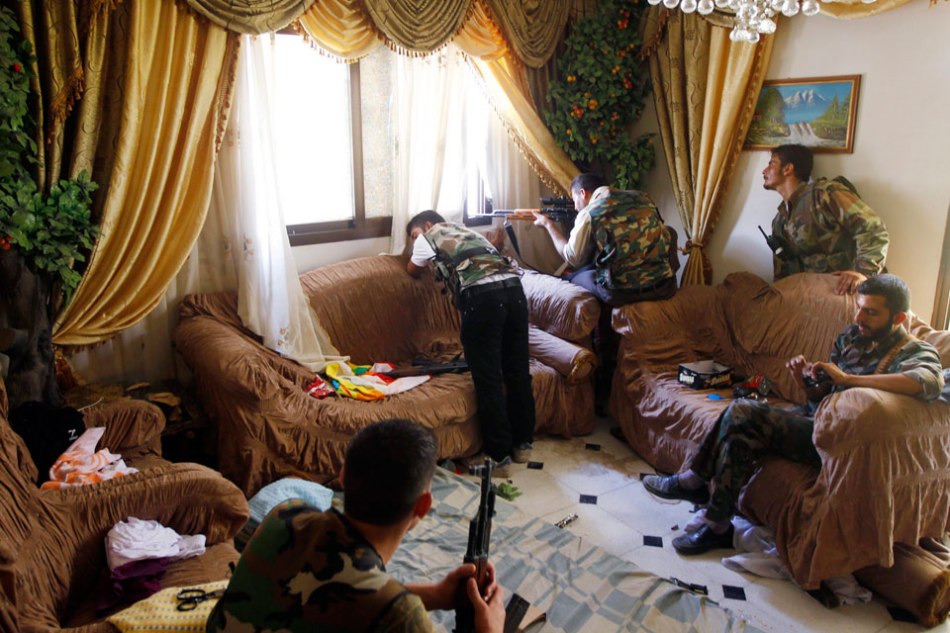Month: August 2012
Nasser Al Hajeb: a life in construction
An Abu Dhabi resident for over 40 years, Nasser Al Hajeb has not only watched the city develop, its fabric is the very story of his life reports Nick Leech
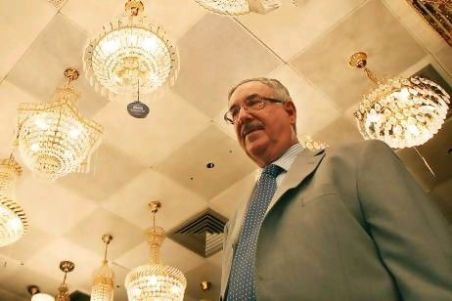
Pawan Singh, The National
At first glance, the Hamdan Street showroom of Crystal House Lights & Gifts seems a most unlikely venue for a conversation about anything other than crystal, lights and gifts.
Ornate mirrors, console tables, and light fittings line the walls, multicoloured crystal chandeliers hang low from the ceiling and tables are loaded with fine crockery, cutlery and delicate porcelain ornaments.
The shop may be decked in silk, gilt, and glass, but it is also home to a historical resource just as rare and invaluable to students of Abu Dhabi’s history as any official document in the National Centre for Documentation and Research.
That resource is Nasser Al Hajeb, the softly spoken, septuagenarian managing partner of Crystal House and an Abu Dhabi resident since 1968.
What sets him apart is not only his remarkable career – he worked on the construction of Abu Dhabi’s first Corniche, Mina Zayed, the existing Presidential Palace, and the Sheikh Zayed Grand Mosque – but the fact that he has recorded it all meticulously in diaries, files, photographs and fading press clippings that line the walls of his office.
The fabric of Mr Al Hajeb’s life in Abu Dhabi is the story of the city.
I was at university in Syria, and I was looking to improve my situation in life,” he said. “I couldn’t find a chance in Damascus, so I went to Kuwait. After a few months, I was asked to come to Abu Dhabi. I knew of Ras Al Khaimah from school but of Abu Dhabi, I knew nothing.”
Overnight, Mr Al Hajeb went from being an accountant with a Kuwaiti contracting company, Al Zamel & Darwish, to being their sole representative in Abu Dhabi.
“When I arrived, the airport was where the Al Ittihad offices are now,” he said. “From there to Al Hosn, the journey was maybe 45 minutes. There was only one road, you couldn’t drive fast because of the sand and you had to keep your car in a low gear.”
For a budding executive out to make a name and a new life for himself, Mr Al Hajeb’s beginnings were not auspicious. His first home was in a subdivided, single-storey, cinder-block building near the site of what is now the Hilton Corniche.
“When I arrived, the owner of the company came with me from Kuwait and after three days he said ‘Yalla! Go.’ I had expected a flat or maybe even a villa and a car but there was nothing,” he said. “I lived in one room. There was no kitchen and the water came from a tank outside and had to be filtered.”
There was also very little for Mr Al Hajeb to do but work. “There was no newspaper, no radio, nowhere to go. There was only one hotel, the Al Ain Palace, and that had only one floor and was always booked six months in advance.”
Given its scarcity at the time, it is perhaps not surprising that many of Mr Al Hajeb’s early memories of life in Abu Dhabi involve the availability and quality of fresh food.
“Until 1970, you couldn’t find fresh food in the market,” he said. “I used to send a boy who worked for me to queue at two companies who brought fresh fruit, vegetables and meat once a week from Lebanon. He stayed in the queue from six or seven o’clock in the morning and … had to wait until he got what I had written for him on a list. I wrote maybe 15 items – he would come back with four or five.”
Not long after his arrival, Mr Al Hajeb won his first major contract, to supply vehicles and excavators to the contractors building Abu Dhabi’s first Corniche. Another major contract soon followed when Al Zamel & Darwish was involved in the construction of the infrastructure for a new port, Mina Zayed.
“After some time, my company came to me and from a small company, in two or three years they found income and improvement,” he said. “We brought one vehicle from Kuwait and I made it nine. We had one excavator from Kuwait and I returned three.”
It was while Mr Al Hajeb was taking delivery of new vehicles that he had his first face-to-face meeting with Sheikh Zayed, an experience he would repeat several times, but one which he remembers vividly.
“His Highness Sheikh Zayed arrived to see a delivery of rice,” he said. “He said, ‘I am the President of this country and I have to make sure that everything is good for my citizens’. Sheikh Zayed asked, ‘From where are you coming?’ and used the Arabic word ‘akhouy’ – ‘my brother’. I knew it was His Highness Sheikh Zayed because I had seen him before on his way back from the harbour. He was driving his car himself.”
Soon after, Mr Al Hajeb made a decision that would alter the course of his life. He left the construction industry and went into business with an Emirati partner selling lighting, chandeliers, luxury wallpaper, porcelain, crystal, and gifts. His timing was opportune as oil revenues were finally starting to manifest themselves in the construction of new government ministries, palaces, houses, and mosques.
One of Mr Al Hajeb’s first public projects was supplying the lighting for what was then the new Sheikh Zayed bin Sultan Mosque on Airport Road, which still stands next to Etisalat headquarters.
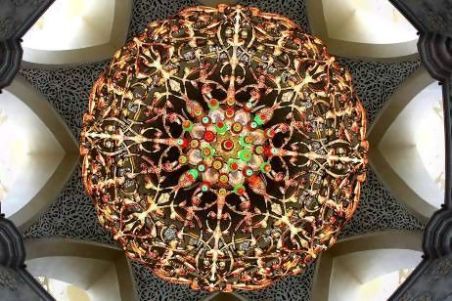
Stephen Lock, The National
Little did he realise that 40 years later, he would also oversee the design and installation of all seven Swarovski crystal chandeliers in the Sheikh Zayed Grand Mosque. When the mosque opened, the centrepiece was reportedly the largest chandelier in the world.
When Mr Al Hajeb’s involvement with the project began in 1994, he had already supplied the chandeliers for the Presidential Palace, but nothing could compare to the stamina and effort required for the Grand Mosque.
“I used to drive to the site three or four times a week for six years,” he said. “If contractors were moving parts of the chandelier, I wanted to know, I was there. I was arranging everything and I needed to be satisfied that everything was going well.”
Mr Al Hajeb and an engineer even stayed in the mosque overnight before its opening in time for Eid Al Fitr in 2007. The next morning, Sheikh Khalifa, President of the UAE, and 20,000 other worshippers came for prayers.
Of all the projects Mr Al Hajeb has been involved with, his role in supplying the lighting for the Sheikh Zayed Grand Mosque is the work that makes him most proud.
“When I see the photos now of people praying under the chandelier during Ramadan, I feel like I made something,” he said.
“Before then, I had hoped to make something of my life and for me, this is the mosque. I saw the mosque, I saw the chandelier, and I thanked God for what had happened.”
When asked about the future, Mr Al Hajeb will not be drawn, but responds with a smile: “Our new projects are really something different. You would not believe what we are working on now. You can say that it would be strange to see these things.”
At the age of 70 and after all he has seen – a family business established, a city transformed and a nation built – Mr Al Hajeb’s next project must be spectacular indeed.
A version of this article originally appeared in The National, Abu Dhabi
Eric Broug: a passion for pattern
Eric Broug discovered Islamic geometry in the late 1980s, while he was studying international relations and Middle Eastern politics in his native Holland. Here he talks to Nick Leech about his passion for Islamic geometrical design and his forthcoming book.
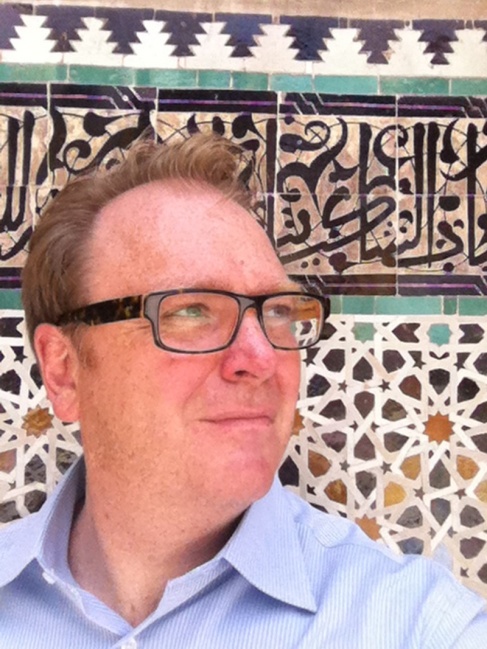
Broug was, he admits, “looking for something that I could be passionate about for the rest of my life”, and it wasn’t long before he realised he’d found it. “There’s a creative component that allows you to develop patterns and embellish them in a certain way, and a scientific aspect that has to do with geometry, rules and with history,” he says.
It was the start of an unwavering obsession that continues to this day – one that led Broug to sell his home and relocate to England. One that has brought him internet fame and resulted in the creation of Broug Ateliers, a company that creates bespoke Islamic geometry for domestic and commercial clients around the world.
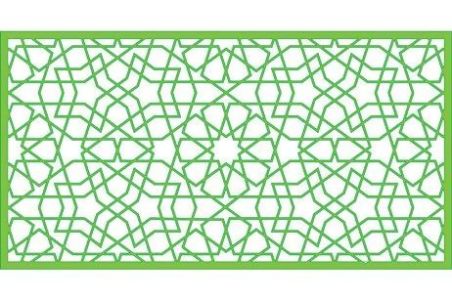
Broug is a busy man, dividing his time between the atelier, his job as the Middle East and North Africa region manager for an academic publishing house in the UK and the manuscript for his latest book – a sumptuously illustrated, 300-page coffee table book on Islamic geometrical design. It’s the first of its type, and is due to be published by Thames & Hudson next year.
A looming deadline means Broug spends his lunch hours working to get the book’s manuscript completed in time for the various editors who need to prepare it for its international launch. This is a long way from Broug’s early hobbyist days, when he used a ruler and a pair of compasses to produce watercolour compositions of Islamic geometrical design in his spare time.
Now he uses professional architectural drafting and modelling software to create his clients’ designs. The finished products include stained glass windows, interior and exterior ornamental screens, mashrabiya, shutters and gates, as well as smaller decorative objects and conversation pieces.
The choice of construction materials and techniques is determined by the project and its budget. External security panels can be made in laser-cut mild steel, or interior panels in computer-numerical-control-routered, medium-density fibreboard, while finer pieces meant to be seen close-up are handmade by master craftsmen using fine woods and traditional joinery techniques. Broug actually discovered one of his craftsman collaborators after he uploaded photos of his work onto the Broug Ateliers Facebook page.
“Most of the people who joined were people who had read my first book and wanted to share photos of the things they’d made using the patterns from it. The quality of one gentleman’s work in particular was so fantastic that I started working with him for clients who wanted something special.”
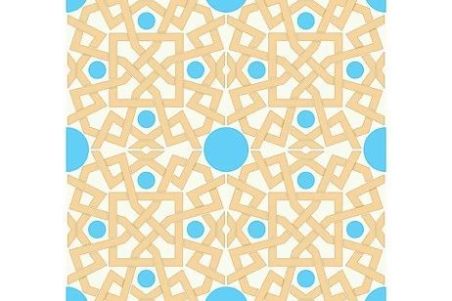
Broug’s first book was a how-to guide complete with a CD-Rom called Islamic Geometric Patterns. “When I started, there were no books that showed you how to make the patterns. They only showed the end result. This just makes it all the more difficult when you see these wonderful patterns but [don’t know] how to make them. I thought I would make a book that shows you how to do it in six to eight steps using a compass and a ruler. I still get quite a bit of fan mail,” Broug says, with an awkward mixture of embarrassment and pride. But he’s clearly not alone in his obsession since the book has been published in Dutch, English, Farsi and even Turkish. Given the source of so much of his inspiration, Broug would also like there to be an Arabic translation.
To make the leap from watercolourist to designer and author, Broug decided to leave the Netherlands, using the proceeds from the sale of his house to fund further study in Islamic architecture and design in the UK. It was a huge risk. “I felt I was at a stage where I wanted my work to be critically assessed. I felt that if I wanted to get better at it I needed to make that move.”
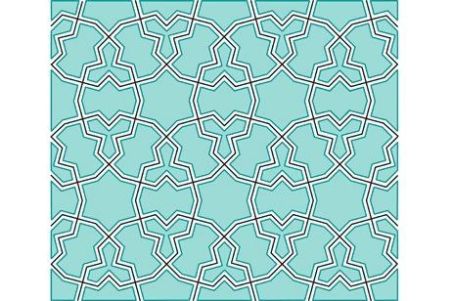
Broug spent a year studying the history of Islamic architecture and design at London’s School of Oriental and African Studies and another year at the Prince’s School of Traditional Arts, part of the foundation established by Prince Charles for the teaching of practical skills associated with the traditional arts, especially of Islam. “It was good because I had one year of academic rigour and another of making things with my hands,” Broug says.
Despite all his studying, the success of his book and the foundation of his atelier, Broug enjoys nothing more than sharing his passion for Islamic geometrical design by showing people how to create the patterns for themselves in public workshops. Broug claims “there’s no substitute” for using a pair of compasses and a ruler to produce the beautiful and seemingly complex patterns in six to eight steps.
Ultimately, for Broug, the real excitement about Islamic geometric design lies in its future, not in its past, and in the variety of contemporary uses to which it can be applied, “not just as something that is historically interesting but as something that appeals to people who are interested in modern homes”.
His other ambition is to expand the repertoire of patterns that are currently in use, particularly in architecture. “I would be delighted if people would be able to use my books to make a greater variety of geometrical patterns. Quite often you just see the usual suspects, a handful of patterns. Typically only 10 to 20 per cent of available patterns are being used and the rest are being consigned to history. They don’t need to be.”
For more information, visit www.broug.com. Small desktop Broug Ateliers screens are also available from Etsy at www.etsy.com/shop/Qaytbay
A version of this article originally appeared in The National, Abu Dhabi
Gulfography: the girls from Dubai are here
Nick Leech speaks to Shammi Samano and Asma Al Kendi, the founders of a new online gallery that’s dedicated to breaking down cultural barriers by bringing art from the Gulf region to a wider audience
“The Girls of Dubai are here!” proclaims Gulfography, a new website and online gallery that’s dedicated to showcasing work by emerging and established artists from the UAE and the wider Gulf region. It’s a loud statement designed to capture the attention but, like so much of the work exhibited on the website, it also contains an ambiguity that forces the viewer to look more closely and reconsider what they think they now about life in the Gulf.
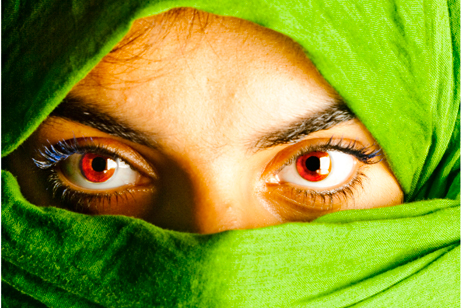
Amina Taher’s self-portrait ‘Power Eyes’ is a case in point. From behind an uncharacteristically green shayla a pair of fiery eyes confront the viewer’s gaze, challenging you to look away or to fathom the picture’s meaning. The image lends itself to a heady mix of possible interpretations, about gender, the veil, and sexual inequality, but for its creator it remains a profoundly personal statement. “Even though I am covered, when you look at my eyes, you can see how I feel inside. If I am in love, or I am sad, or I am happy. That picture describes me, Amina Taher.”
Taher’s self-portrait is one of a set of images on Gulfography that are selected from Privately, a 2010 exhibition that showcased the work of eighteen applied communications students from Dubai Women’s College. The show attracted large numbers of visitors and substantial attention from the media, and provided its curator, the Iraqi-born artist and filmmaker Shammi Samano, with the inspiration for Gulfography. “I realised there was an empty space. Local photographers, especially women, were expressing themselves in interesting and provocative ways with subject matter that was quite different from the themes you traditionally see in local photography.”

For Samano, Privately had provided an eloquent and challenging insight into the lives of young women in the UAE, an experience defined by “a desire for more freedom, for more power, loneliness, wanting to talk but not feeling like you could, feeling trapped by judgements.”The show also introduced Samano to her fellow Gulfography co-founder Asma Al Kendi, an Emirati and Dubai Women’s College alumnus with a bachelor’s degree in computer science. Gulfography is the result of their collective passions, skills, and desire to provide a platform for artists who felt intimidated by the art world and traditional gallery system.
“A lot of work ends up on Facebook and Flickr. You find gems or particular photographers who are doing really interesting work, but there was no space for it. That was the tragedy. These people are artists with something to say and with a sound aesthetic vision and they should have somewhere that’s professional to display and that’s more global than a physical space.”
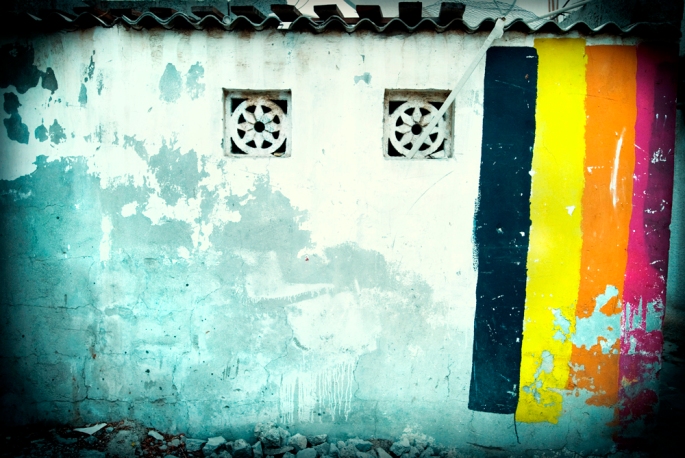
Samano’s assessment is borne out by the artists themselves. Asma Faisal is another graduate from Dubai Women’s College whose work now features extensively on Gulfography. “I think the initiative that Shammi took provides amazing support for us. Gulfography is the first time I’ve published my pictures. I never showed people my photos before, I just took them and kept them for me. To showcase my photos outside of my family and friends was a huge step.”
If Gulfography is the product of Samano and Al Kendi’s vision, it also results from their experiences as women from the Middle East who now live in the West. For Samano, this factor played an important role in encouraging her to “do something that connects to our culture but which also speaks to the West and opens up a dialogue.” For Al Kendi, inspiration came from the ignorance and widespread misconceptions about the UAE that she encountered outside the region.
“When I arrived at San Francisco airport, the first thing the passport control officer asked me was ‘Where is your burqa? Where is your camel? Are you allowed to travel without a man?’ Nobody knows about the local artists here who are ambitious, bold, and strong and who want to send a message that we are a creative and educated people. We are not violent or oppressed. I wanted to represent something about the area that I came from and I wanted people to know that there is more to Dubai.”

For Samano and Al Kendi, it was important to create an online gallery that would provide an international platform for artists from the Gulf however, exhibitions and physical work play an important role in their plans for Gulfography’s future, as Samano explains. “Physical exhibits will always be a part of what Gulfography is about. The physical and the virtual have to work together and even though the images look great online, there’s nothing like seeing a physical print on paper, exhibited in a gallery space. It’s its own kind of experience.”
Samano and Al Kendi are currently in the process of planning the first Gulfography exhibition in the West. This will see the work of young female photographers from Dubai, as well as the noted Yemeni photojournalist Amira Al Sharif, exhibited in a gallery in San Francisco in late October and longer-term plans include the production of a book however, Samano and Al Kendi are keen not to place any restrictions or limits on Gulfography’s future. Al Kendi repeatedly refers to ‘the bigger picture’.
“We’re not just trying to sell and showcase art. We’re trying to build a bridge between the West and the East and we’re sending different messages to people who don’t know anything about the Gulf region. We’re trying to connect this side of the world with the other.”
Samano and Al Kendi are also keen to expand Gulfography’s scope beyond photography, and to show work by male artists, by expats from the Middle East diaspora, as well as foreign expats with experience of life in the Gulf. To that end, Samano is currently developing an exhibition entitled Expat Mirages with a female Western expatriate who has lived in the UAE. “The expat experience plays a large part of the story of the Gulf” says Samano, “it’s its own story and its own thing.”
Other artists currently featured on Gulfography include Alia Al Falasi, Atiya Al Marri, Azza Al Owais, Reem Al Falahi, and Roudha K. Al Shamsi. For more information, or to view/purchase images, see http://www.gulfography.com. Prices start from around Dhs550.
This article originally appeared in The National, Abu Dhabi

